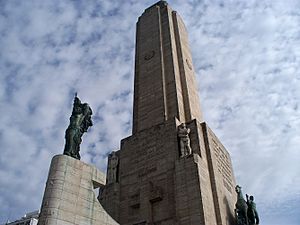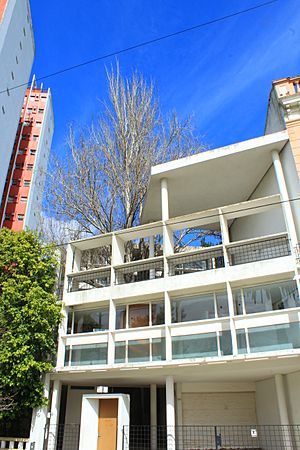List of National Historic Monuments of Argentina facts for kids
The National Historic Monuments of Argentina are special places in Argentina. They are buildings, sites, or features that the government has officially called "historic." This means they are very important to Argentina's past.
These monuments get extra protection from a group called the Comisión Nacional de Museos, Monumentos y Lugares Históricos. This group was started in 1940. Besides the national list, each province in Argentina also has its own list of important historic places.
There are about 400 places on the national list. Many of them are old buildings or sites from before Argentina became a country, or from its early days as a colony. Some are battlefields or other spots linked to Argentina's fight for independence. Lately, the government has also been adding places that show Argentina's industrial growth and the story of its immigrants.
Contents
- Historic Treasures in Buenos Aires City
- Historic Places in Buenos Aires Province
- Historic Places Across Argentina
- Catamarca Province
- Chaco Province
- Chubut Province
- Córdoba Province
- Corrientes Province
- Entre Ríos Province
- Formosa Province
- Jujuy Province
- La Rioja Province
- Mendoza Province
- Misiones Province
- Río Negro Province
- Salta Province
- San Juan Province
- San Luis Province
- Santa Cruz Province
- Santa Fe Province
- Santiago del Estero Province
- Tierra del Fuego Province, Argentine Antarctica and South Atlantic Islands
- Tucumán Province
- National Historic Places
- See also
Historic Treasures in Buenos Aires City
Buenos Aires, the capital city, has many famous historic monuments. These places tell stories of how the city and the country grew.
Famous Buildings and Landmarks
- Café Tortoni: An old and beautiful coffee shop, opened in 1858.
- Casa Rosada: This is the "Pink House," where the President of Argentina works. It was finished in 1898.
- Buenos Aires Botanical Garden: A lovely garden created in 1898.
- Buenos Aires Cabildo: A very old building from the 17th century. It was once the city's government house.
- Buenos Aires Metropolitan Cathedral: A grand church built in the 18th and 19th centuries.
- The 'May Pyramid' monument: Found in the Plaza de Mayo, this monument was built in 1811.
- Obelisk of Buenos Aires: A tall, famous landmark from 1936.
- Congressional Palace of Argentina: Where Argentina's laws are made, completed in 1906.
- Teatro Colón: A world-famous opera house from 1908.
- Galerías Pacífico: A beautiful shopping mall.
- Barolo Palace: A unique building finished in 1923.
- Kavanagh Building: A tall, impressive building from 1935.
- Hotel de Inmigrantes: This building from 1906 is now a museum about immigrants.
- ARA Presidente Sarmiento: An old ship from 1872.
- Corbeta Uruguay: Another historic ship from 1874.
- Buenos Aires Customs: The old customs building from 1910.
- Palacio de Aguas Corrientes: A stunning water pumping station built in 1894.
Historic Churches and Convents
Many old churches and religious buildings are also national monuments.
- Our Lady of the Rosary Basilica and Santo Domingo Convent: From the late 18th century.
- San Roque Chapel: Also from the late 18th century.
- San Miguel Church: Built in 1788.
- San Juan Church: From 1797.
- San Pedro Telmo Church: Built in 1734.
- San Ignacio Church: Part of the Manzana de las Luces (Block of Lights), from 1722.
- Former Jesuit buildings, Manzana de las Luces: Built between 1730 and 1780.
- San Francisco Basilica: From 1754.
- Montserrat Church: Built in 1865.
- Basilica of Our Lady of Mercy: From 1779.
Other Important Sites
- Buenos Aires Zoo: Started in 1875.
- Club de Pescadores: A fishing club and pier from 1937.
- Argentine Yacht Club: From 1911.
- National Historical Museum: The former home of Gregorio Lezama.
- Buenos Aires Metro stations: Several old and beautiful subway stations on Lines A, C, D, and E are also protected.
Historic Places in Buenos Aires Province
The province surrounding Buenos Aires city also has many important sites.
- Curutchet House, La Plata: A famous house that is also a World Heritage Site.
- Museum of Natural Sciences of La Plata: An important museum in La Plata.
- Basilica of Our Lady of Luján: A very important church for many Argentinians.
- Old Bridge, San Antonio de Areco: A historic bridge.
- Parque Criollo and Ricardo Güiraldes Gaucho Museum, San Antonio de Areco: Dedicated to gaucho culture.
- Estancia 'La Porteña', San Antonio de Areco: A historic ranch.
- Quinta Pueyrredón, San Isidro: A historic country house.
- Villa Ocampo, San Isidro: Another important historic house from 1890.
Historic Places Across Argentina
Many other provinces also have their own special historic monuments.
Catamarca Province
- Basílica Nuestra Señora del Valle, San Fernando del Valle de Catamarca: A significant basilica.
- Church at Hualfín: An old church.
- Remains of Pucara de Aconquija, Ambato Department: Ancient ruins.
- Inca settlement at El Shincal de Quimivil, Belén Department: An important Inca site.
Chaco Province
- Former government house, Resistencia: Now a police museum.
- Former Francés Railway Station, Resistencia: Now a natural history museum.
Chubut Province
- La Trochita, Esquel: A historic narrow-gauge railway.
- Remains of Fort San José de la Candelaria, Gulf of San José: Old fort ruins.
Córdoba Province
- Córdoba Cabildo: A 17th-century government building.
Corrientes Province
- Holy Cross of Miracles Church, Corrientes: Built in 1887.
- Church of Santa Ana of the Guácara Indians, Santa Ana: From 1765.
Entre Ríos Province
- Cathedral of Paraná: A beautiful cathedral.
- Palacio San José, near Concepción del Uruguay: A historic palace.
Formosa Province
- Government House, Formosa.
- House of governor Ignacio Fotheringham, Formosa: Now a provincial historic museum.
Jujuy Province
- Cathedral of San Salvador de Jujuy.
- Cabildo of San Salvador de Jujuy: Now a police history museum.
- San Francisco Chapel, Tilcara.
- Santa Rosa Church, Purmamarca.
La Rioja Province
- Temple and Convent of Santo Domingo, La Rioja.
Mendoza Province
- Basilica of San Francisco, Mendoza: Built between 1875 and 1893.
- Vaults of Uspallata, Las Heras Department: From the late 18th century.
- Chapel and Oratory of Alto Salvador, San Martín Department: From 1852.
- Ruins of the Malal Hue Fort and the Rufino Ortega Historic Mill, Malargüe: From 1846 and 1885.
- Ruins of San Rafael del Diamante Fort, Villa 25 de Mayo, San Rafael Department: From 1805.
- Ruins of the Jesuit church of San Francisco, Mendoza: Built between 1716 and 1731.
- Former Bodega Arizu, Godoy Cruz: A historic winery from 1888–1910.
- Farm of General San Martín, San Martín Department: From 1823.
- Ruins of San Carlos Fort, San Carlos Department: From 1770.
- Pedro del Castillo Square, the old Plaza Mayor of Mendoza: The original main square from 1561.
- Training ground of the Ejército de los Andes, Mendoza: Where General San Martín's army trained between 1814 and 1817.
- Cristo Redentor de Los Andes, Las Heras: A famous statue in the Andes mountains.
Historic Battlefields
- Site of the Battle of Potrerillos, Luján de Cuyo: From 1817.
- Site of the Battle of Rodeo del Medio, Maipú: From 1841.
Misiones Province
- Government House, Posadas.
Río Negro Province
- Civic complex, San Carlos de Bariloche: A famous group of buildings.
Salta Province
- Salta Cathedral: Includes the Pantheon of the Glories of the North and the tomb of Martín Güemes.
- Monument to Martín Güemes, Salta.
- Cabildo of Salta: Now the Historical Museum of the North.
- San Francisco church, Salta.
- San Bernardo convent, Salta.
- Pre-Hispanic settlement of Santa Rosa de Tastil, Rosario de Lerma Department: An ancient settlement.
San Juan Province
- Birthplace of Domingo Sarmiento, San Juan: The home of a very important Argentine president and educator.
- Church and Convent of Santo Domingo, San Juan.
San Luis Province
- Our Lady of the Rosary church, Villa de Merlo.
- House of Domingo Sarmiento, San Francisco del Monte de Oro.
Santa Cruz Province
- Prehistoric rock art/cave site, Cueva de las Manos: Famous for its ancient cave paintings.
Santa Fe Province
- National Flag Memorial, Rosario: A huge monument dedicated to the Argentine flag.
- Villa Hortensia, Rosario.
- Central Post Office, Rosario.
- Santa Fe la Vieja: The site of the original city of Santa Fe.
Santiago del Estero Province
- Bridge across Río Dulce: Connects Santiago del Estero and La Banda.
- Cathedral of Santiago del Estero.
Tierra del Fuego Province, Argentine Antarctica and South Atlantic Islands
- Harberton Station, Isla Grande de Tierra del Fuego: An old ranch.
- Capilla Nuestra Señora de la Candelaria Misión Salesiana, Río Grande: A historic chapel.
- Snow Hill Cabin: Used by an Antarctic expedition.
- Monumento Islas Malvinas, Ushuaia: A monument to the Malvinas Islands.
- Parish church of Ushuaia.
- Año Nuevo lighthouse, Isla Observatorio: A lighthouse on an island.
Tucumán Province
- House of Tucumán: Where Argentina declared its independence.
- Tucumán Cathedral.
- Provincial Historical Museum, Tucumán.
- Church of San Francisco, Tucumán.
National Historic Places
Besides the monuments, some places are called 'National Historic Places'. These are also very important to Argentina's history.
- Plaza Dorrego, San Telmo, Buenos Aires: A historic square.
- Plaza de Mayo, Buenos Aires: A very important square in Argentine history.
- Avenida de Mayo, Buenos Aires: A grand avenue.
- Plaza de los Dos Congresos, Buenos Aires.
- House of Carlos Gardel, Abasto, Buenos Aires: Home of a famous tango singer.
- Ciudad Evita, La Matanza Partido, Buenos Aires Province: A planned city.
- Puerto Bermejo, Chaco Province.
- Ruins of the city of Concepción de Buena Esperanza, Chaco Province.
- San Juan de Salvamento Port, Isla de los Estados, Tierra del Fuego Province.
- 9 de Julio Park, Tucumán, Tucumán Province.
See also
- Category:World Heritage Sites in Argentina
- National Parks of Argentina




